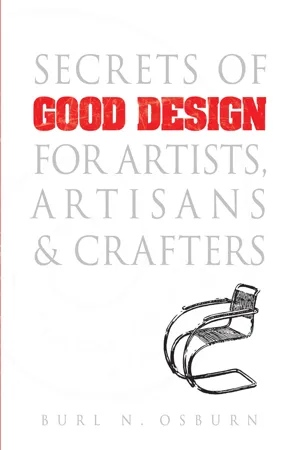
- 112 pages
- English
- ePUB (mobile friendly)
- Available on iOS & Android
Secrets of Good Design for Artists, Artisans and Crafters
About This Book
Practical and aesthetically pleasing, this visual meditation on the constituents of good design considers all manner of construction, form, and ornamentation. It answers many questions about design choices, from basic to specific, with clear, concise, and practical directions. The book's appeal lies chiefly in the integrity of its own design, consisting of hand-lettered text and pleasingly styled and proportioned illustrations.
Author Burl N. Osburn addresses basic questions — What are the qualities of good design, and how does balance affect design? What is good proportion, and how is ornament used? — and explores design choices in a variety of expressions. Featured arts and crafts include the use of wrought iron, methods of cutting wood, the decoration of clay and leather, the basic textile structures, the nature of the tapestry weave and design of block-printed textile, the development of repeat pattern and the geometry of repeating ornament, and attaining typographic unity. Students learn to analyze a project's requirements, draw up specifications, and design the final product. A valuable guide for teachers and students, this volume also constitutes a practical resource for professional and amateur artists and crafters.
Frequently asked questions
Information









Table of contents
- Cover
- Title Page
- Copyright Page
- Foreword
- Introduction
- Table of Contents
- What does “design” mean?
- What can the designer believe?
- Must the designer consider economics?
- What are-the qualities of good design?
- How does the designer achieve beauty?
- How does the designer think out a plan?
- How are constructed articles described?
- How does the designer secure order?
- What is meant by the term “function”?
- How does balance affect design?
- What is good proportion?
- What are the purposes of ornament?
- How is ornament used?
- Should the designer understand symbolism ?
- Can the circle be used in design?
- What is a good curved line?
- How may curves be combined?
- How can the designer use wrought iron?
- What are the design elements in thin metal?
- In what ways is cast metal used?
- How has metal been used in folk arts ?
- How has the machine affected design in metal?
- Does structure influence design in wood?
- What methods of cutting wood are available?
- What decorative methods are used on wood?
- Need the designer know period styles?
- How is turned work designed?
- What are the types of turned work?
- How is a design for turned work used?
- What are the design elements in clay?
- How is clay decorated?
- What are the forms of pottery vessels?
- How are templates made for pottery?
- What design variables are there in leather?
- What decorative processes suit leather?
- What are the basic textile structures?
- How are textiles decorated?
- What is the nature of the tapestry weave?
- How is pattern weaving designed?
- How is the block-printed textile designed?
- How is the stencil designed?
- How is a repeat pattern developed?
- Is there a geometry of repeating ornament?
- What are the types of plastics?
- Can the handworker use plastics?
- What are the design elements in letters?
- What factors influence letter design?
- How are new letters derived?
- What is an appropriate letter form?
- How is typographic unity attained?
- How is a regular type mass balanced?
- Can type pages balance on the vertical axis?
- How is good proportion attained?
- How is typography designed?
- Does paper count in typographic design?
- What factors makes a good bookplate?
- How is a measured drawing made?
- How is a “morgue” formed?
- Problems of analysis of requirements
- Problems of function
- Problems of order
- Problem in balance
- Problems in geometric form
- Problems in the use of free hand curves
- Problems in wrought iron
- Problems in thin-gauge metals
- Problems in cast metal
- Problems in wood
- Problems in ceramics
- Problems in leather
- Problems in textiles
- Problems in graphic arts
- Problems in plastics
- Bibliography